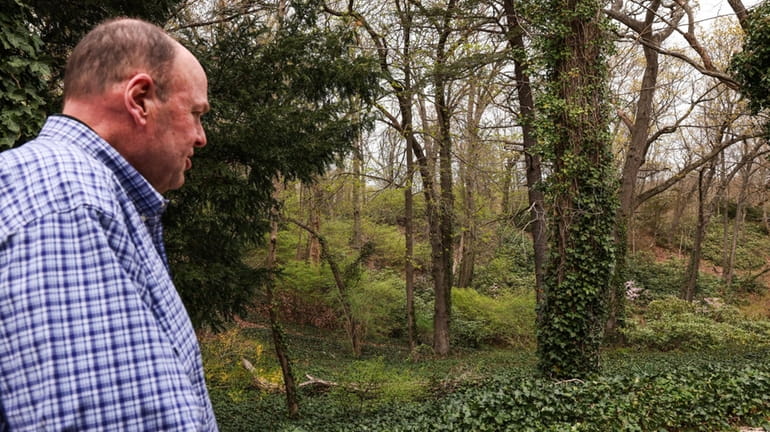Vineyard Bay Estates subdivision plan faces lawsuit from Halesite neighbors

Paul Thomson, of Halesite, stands near a parcel of undeveloped land that's the site of a planned subdivision across the street from his home. Credit: Newsday/Steve Pfost
A 10-acre parcel in the wooded hills of Halesite where Cooper’s hawks and foxes mix with rhododendrons and azaleas is at the center of a lawsuit.
A group of neighbors who live across the street from the parcel in the hamlet say the land, which dates back more than 75 years in its current form, is environmentally significant and should be preserved as open space.
But the property owners, developers Stanley Weissberg and Walter Morris — the principals in Vineyard Bay Estates LLC and Vineyard Estates LLC — have preliminary approval from the Town of Huntington's planning board to build an eight-home subdivision on the site.
The neighbors, who formed the Nathan Hale Nature Preserve Committee to oppose the subdivision, sued Huntington's planning board, the Village of Huntington Bay and the developers in Suffolk County State Supreme Court in March.
WHAT TO KNOW
- Members of the Halesite-based Nathan Hale Nature Preserve Committee oppose an eight-home subdivision in their neighborhood because they want to preserve a piece of land populated by a variety of animals, birds, plants and trees.
- The group sued the developers, the Town of Huntington Planning Board and the Village of Huntington Bay in March to stop the project.
- The lawyer for the developers said all laws and procedures were followed in the planning board granting preliminary subdivision approval.
The lawsuit contends the planning board “rushed” to push the project through. It argues the steep slope of the parcel makes it unsuitable for development and the planning board didn't follow its own internal procedures or laws relating to the town’s steep-slope ordinance. The litigation also says the approval doesn't comply with state environmental law.
The committee wants the court to annul the preliminary approval of the subdivision, force a full environmental study of the property, halt any development on the parcel and reimburse the committee for costs and attorney fees.
“We fear and know there is going to be a significant loss of habitat and deforestation of old growth,” said Paul Thomson, one of eight members of the committee. “We had no choice but to sue.”
Thomson is one of six plaintiffs named in the lawsuit, along with the Nathan Hale Nature Preserve Inc. and four other neighbors.
Town of Huntington spokeswoman Christine Geed says the town doesn't comment on current or pending litigation. Planning Board Chair Paul Ehrlich couldn't be reached for comment.
Anthony S. Guardino, an attorney for the Village of Huntington Bay, said he advised village officials they shouldn't have been named in the lawsuit.
However, Michael McCarthy, an attorney for the developers, said the planning board studied the application and complied with all local and state laws in giving preliminary approval.
“I think the court is going to determine that the planning board acted properly,” McCarthy said, “that it reviewed all of the information that was presented and came to the proper conclusion.”
Once preliminary approval is given, the planning board sets another public hearing to consider giving conditional final subdivision approval. The public is allowed to address the board. McCarthy said generally at that final public hearing the planning board asked for more review of areas such as driveway placement or the stormwater retention plan.
The developers plan to use 4 acres of the 10-acre plot, McCarthy said. The remaining land will be kept as open space. About 1.8 acres of the land that will remain open space is in the Village of Huntington Bay.
The eight homes are to be built on land between Bay Avenue and Vineyard Road. Five of the eight parcels will include land that can never be developed. Approximately 200 trees will be removed from the property, which is about 10% of all the trees on the 10 acres, McCarthy said. He said four of the homes would have retaining walls of varying heights and lengths.
Town of Huntington records show that the planning board conducted an environmental review before giving preliminary approval to the development. Because the developers are preserving 6 acres of the property, the review determined there would be no significant environmental impact if the project moved forward.
Thomson questions that determination because, he said, no specific public hearing was held on the matter. State environmental law, he added, “mandates a hard look when looking at potential impact from developments, especially when looking at steep slope and old growth forests.”
Huntington amended town code in 2005, town officials said, to address properties that have a vertical rise of at least 10 feet or higher on a 100-foot-wide lot. The steep-slope ordinance provides a mathematical formula that results in larger building lots, depending upon the severity of the slope in question, according to Huntington officials.
But the steep slope ordinance doesn't preclude development, McCarthy said.
At an August planning board public hearing, the board suggested some changes to the developers — including moving one of the houses — after residents had a chance to weigh in on preliminary subdivision approval.
The planning board then closed the hearing to oral public comments, upsetting residents. Written comments are accepted throughout the process, town officials said.
The planning department presented a new plan from the developer at an October planning board meeting that included moving one home from Bay Avenue to Vineyard Road. The board granted preliminary approval for the subdivision in February.
Before the board's vote on Feb. 21, Ehrlich said the application had been under consideration for years.
“All of the proper analysis has been taken,” he said.
